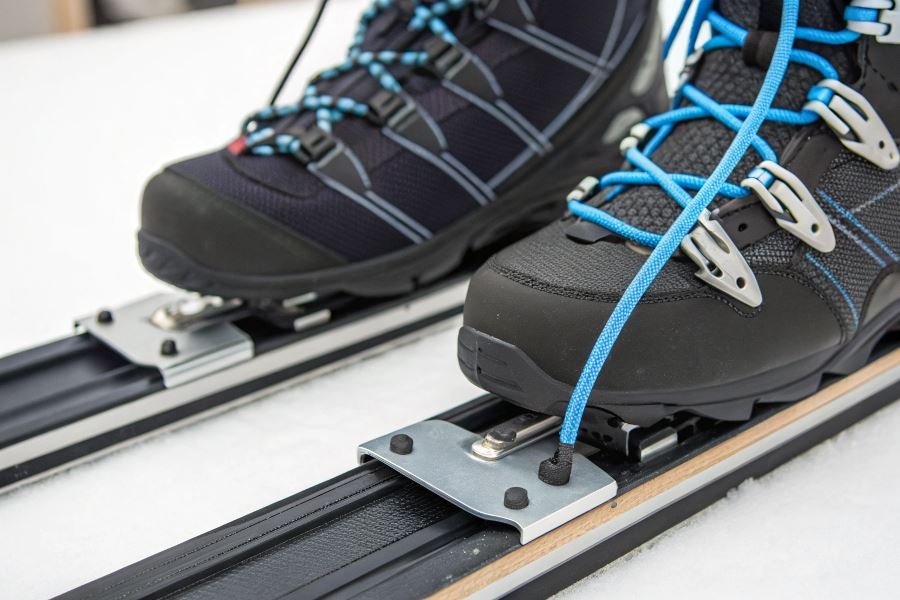
Ever watched a skier glide effortlessly across pristine snow, wondering what invisible magic connects them to their skis? That connection isn’t magic—it’s engineering precision between bindings and boots that can transform your cross-country experience from frustrating to phenomenal.
Cross-country ski binding and boot compatibility isn’t just a technical footnote—it’s the foundation of every stride you take on snow. When these components work in harmony, you’ll experience better power transfer, enhanced control, and significantly reduced injury risk. When they don’t? Even Olympic-caliber technique can’t overcome equipment that’s fighting itself.
Modern cross-country skiing features several distinct binding systems, each with dedicated boot partners. The primary players include the New Nordic Norm (NNN), Prolink, and SNS systems. These aren’t interchangeable—attempting to mix systems is like trying to connect Apple chargers to Android phones. Impossible fit, guaranteed frustration.
Performance implications of proper compatibility
The binding-boot interface directly affects three crucial aspects of your skiing:
- Performance efficiency: Properly matched systems transfer up to 30% more power from your legs to the snow
- Safety factors: Incompatible systems increase fall risk and can damage equipment
- Comfort level: Even slight mismatches create pressure points that can turn a joyful outing into a painful ordeal
The technology behind these systems has evolved dramatically, with manufacturers developing proprietary designs that optimize specific skiing styles. Whether you’re classic skiing through serene forests or skate skiing for cardio intensity, your binding-boot relationship determines how much energy reaches your skis—and ultimately, how much you’ll enjoy the experience.
The Perfect Match: Navigating Cross-Country Ski Binding Systems
When you’re gliding through pristine snow trails, the last thing you want is equipment failure. The connection between your boots and skis isn’t just important—it’s everything. Finding the right compatibility between cross-country ski bindings and boots can make the difference between an exhilarating outdoor experience and a frustrating walk back to the lodge.
The compatibility of bindings and boots for cross-country skiing follows specific systems that have evolved over decades. Understanding these systems isn’t just for gear nerds—it’s essential knowledge for anyone who wants to invest in equipment that works seamlessly together. Let’s break down the major binding systems and how to navigate them with confidence.
NNN: The Industry Standard
The New Nordic Norm (NNN) system, developed by Rottefella, has become the dominant binding system in cross-country skiing. NNN bindings feature two raised ridges that match with corresponding grooves in compatible boots.
Key NNN specifications:
- Two parallel rails that guide the boot
- A single metal rod at the toe of the boot that clicks into the binding
- Automatic step-in engagement
- Manual or automatic release mechanisms
NNN bindings come in several variations, including the performance-oriented NNN Race and recreational NNN BC (BackCountry). The critical factor is that all NNN boots will work with all NNN bindings of the same category—standard NNN boots won’t work with NNN BC bindings and vice versa.
SNS: The Alternative Approach
The Salomon Nordic System (SNS) from Salomon offers a different design philosophy. Unlike NNN’s two-rail system, SNS uses a single, wider central ridge.
SNS has evolved through several generations:
| SNS Version | Key Features | Compatibility Notes |
|---|---|---|
| SNS Profil | Single wide rail, one metal rod | Not compatible with Pilot |
| SNS Pilot | Single rail, two metal rods | Not compatible with Profil |
| SNS Access | Recreational version | Compatible with Profil bindings |
The SNS system has been gradually losing market share since 2015, with fewer new boot models being produced. If you’re investing in new equipment, this is worth considering for long-term compatibility.
Prolink/NNN: The Compatibility Revolution
In a move that sent shockwaves through the nordic skiing world, Salomon introduced the Prolink system in 2016. This system is essentially NNN-compatible, meaning Prolink boots work with NNN bindings and vice versa.
Why this matters:
- Dramatically expanded boot options for skiers
- Simplified inventory for retailers
- Reduced confusion for newcomers to the sport
The Prolink system maintains Salomon’s reputation for quality while adopting the more widely-used NNN interface. This crossover compatibility has been a game-changer, especially for those upgrading from older equipment.
Universal Options and Adapters
For those caught between systems, several solutions exist:
- Multi-norm bindings like the Turnamic system from Fischer offer compatibility with both NNN and Prolink boots
- Adapter plates can convert some binding types, though these are typically temporary solutions
- Rental plates allow mounting multiple binding types on the same ski
When purchasing new equipment, the smartest approach is to commit to either the NNN/Prolink ecosystem or, if you have existing SNS equipment you love, to stick with that system until you’re ready for a complete upgrade.
Remember that binding-boot compatibility isn’t just about what fits—it’s about performance, power transfer, and ultimately, your enjoyment on the trails.
Mastering the Perfect Match: Binding and Boot Compatibility
Cross-country skiing performance hinges on the seamless interaction between your boots and bindings. This critical connection point transfers every ounce of your energy to the snow, making compatibility not just important—it’s essential. Let’s dive into the final considerations that will ensure your setup performs flawlessly on any terrain.
Matching bindings and boots across skiing styles
Different skiing disciplines demand specific binding-boot combinations to maximize performance. For classic skiing, the binding must allow natural foot flexion while maintaining stability. The NNN (New Nordic Norm) and Prolink systems excel here with their two-rail design that permits the perfect blend of control and natural movement.
For skate skiing, where lateral stability is paramount, systems like SNS Pilot with their additional third rail provide enhanced power transfer during the pushing phase. The extra connection point creates a more responsive platform that serious skaters will immediately notice.
Backcountry enthusiasts face a different challenge altogether. The Rottefella NNN BC binding system offers a wider, more robust platform with additional metal components to withstand off-trail abuse. These must be paired with compatible NNN BC boots featuring the corresponding wider binding interface.
The golden rule: never mix binding systems. An NNN boot will never work with an SNS binding, regardless of how similar they might appear.
| Skiing Style | Recommended Binding System | Key Compatibility Feature |
|---|---|---|
| Classic | NNN, Prolink | Two-rail system, moderate flex |
| Skate | SNS Pilot, NNN Race | Enhanced lateral stability |
| Backcountry | NNN BC, Magnum | Wider platform, robust construction |
| Touring | NNN, Prolink | Comfort-oriented flex patterns |
Troubleshooting common compatibility issues
Even with matching systems, skiers often encounter frustrating compatibility problems. If you experience excessive movement between your boot and binding, check for debris in the binding mechanism or worn boot soles. A simple cleaning can often restore proper connection.
Boot-binding combinations that feel unstable laterally might indicate a mismatch between your skiing style and binding choice. Skate skiers using touring bindings will feel this immediately as a lack of power transfer during the push phase.
Clicking sounds while skiing typically signal improper engagement. This requires immediate attention as it indicates the boot isn’t fully secured—a potential safety hazard. Remove any ice buildup and ensure the binding mechanism closes completely around the boot’s binding bar.
Perfect compatibility feels invisible—you should never think about your boot-binding interface while skiing. The moment it demands your attention is the moment something needs adjustment.
Future innovations in binding-boot integration
The cross-country binding landscape continues to evolve with exciting developments on the horizon. Manufacturers are exploring integrated power sensors that provide real-time feedback on technique and efficiency through smartphone connectivity.
Quick-change binding plates are gaining popularity, allowing skiers to swap between different binding systems without remounting. This innovation particularly benefits those who own multiple pairs of boots or share equipment within families.
Material science advances are yielding lighter yet stronger binding components. Carbon-reinforced composites are replacing traditional plastics in high-performance models, reducing weight while improving power transfer and durability.
The most promising development may be the industry’s gradual move toward standardization. Major manufacturers are increasingly collaborating on compatible interfaces, potentially ending the frustrating “binding wars” that have complicated equipment choices for decades.
By understanding these compatibility fundamentals, troubleshooting common issues, and staying informed about emerging technologies, you’ll ensure your cross-country setup delivers the performance and reliability you deserve on every outing.
